tow FIAT STILO 2006 1.G Owner's Manual
[x] Cancel search | Manufacturer: FIAT, Model Year: 2006, Model line: STILO, Model: FIAT STILO 2006 1.GPages: 274, PDF Size: 4.76 MB
Page 170 of 274
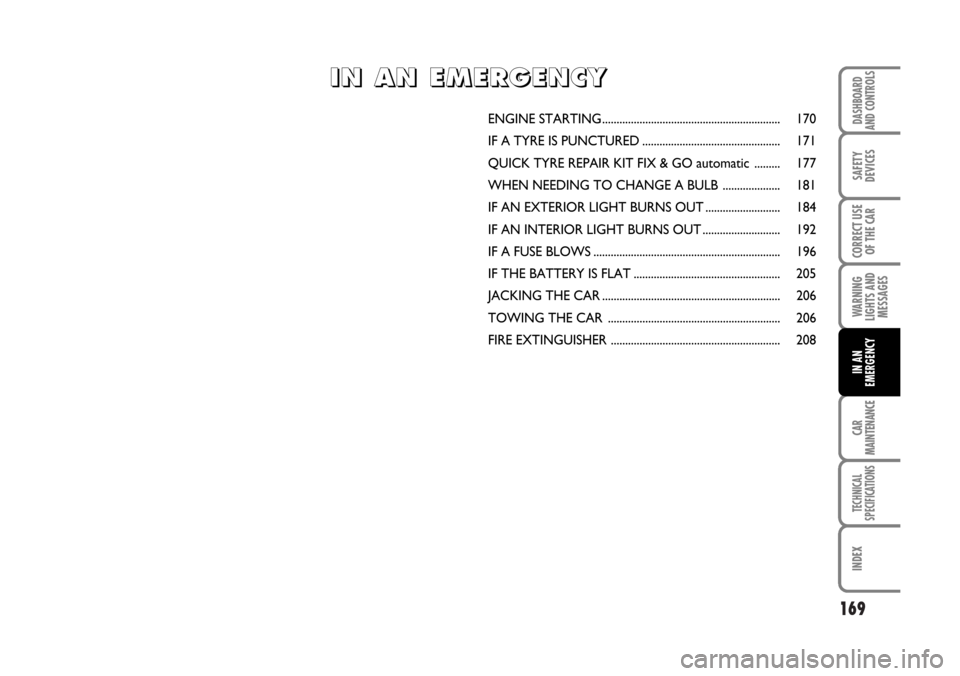
169
WARNING
LIGHTS AND
MESSAGES
CAR
MAINTENANCE
TECHNICAL
SPECIFICATIONS
INDEX
DASHBOARD
AND CONTROLS
SAFETY
DEVICES
CORRECT USE
OF THE CAR
IN AN
EMERGENCY
ENGINE STARTING.............................................................. 170
IF A TYRE IS PUNCTURED ................................................ 171
QUICK TYRE REPAIR KIT FIX & GO automatic ......... 177
WHEN NEEDING TO CHANGE A BULB .................... 181
IF AN EXTERIOR LIGHT BURNS OUT .......................... 184
IF AN INTERIOR LIGHT BURNS OUT ........................... 192
IF A FUSE BLOWS ................................................................. 196
IF THE BATTERY IS FLAT ................................................... 205
JACKING THE CAR .............................................................. 206
TOWING THE CAR ............................................................ 206
FIRE EXTINGUISHER ........................................................... 208
I I
N N
A A
N N
E E
M M
E E
R R
G G
E E
N N
C C
Y Y
Page 171 of 274
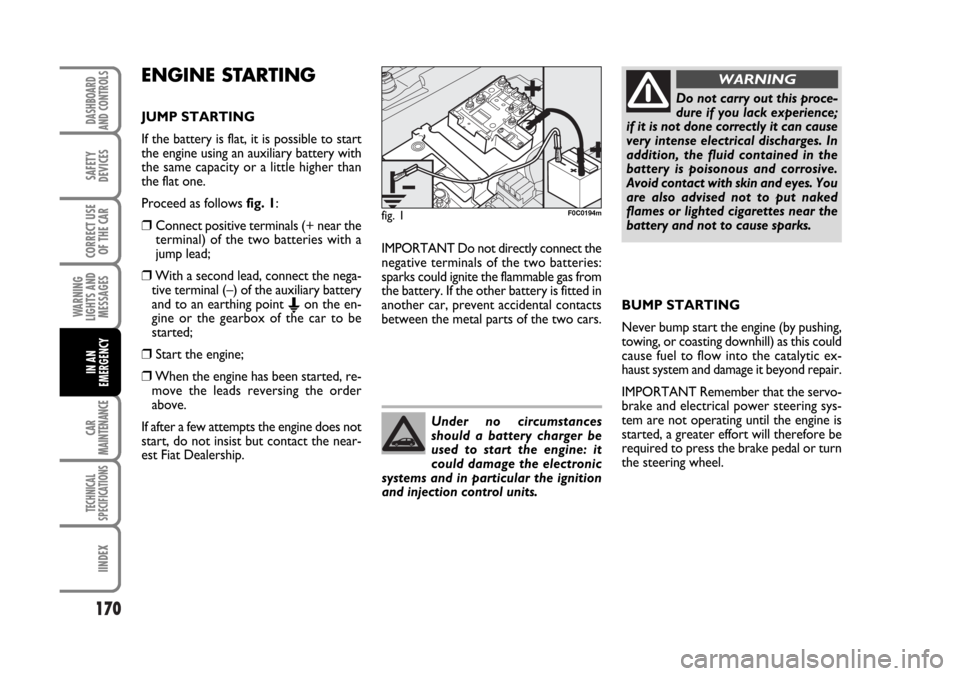
170
WARNING
LIGHTS AND
MESSAGES
CAR
MAINTENANCE
TECHNICAL
SPECIFICATIONS
IINDEX
DASHBOARD
AND CONTROLS
SAFETY
DEVICES
CORRECT USE
OF THE CAR
IN AN
EMERGENCY
ENGINE STARTING
JUMP STARTING
If the battery is flat, it is possible to start
the engine using an auxiliary battery with
the same capacity or a little higher than
the flat one.
Proceed as follows fig. 1:
❒Connect positive terminals (+ near the
terminal) of the two batteries with a
jump lead;
❒With a second lead, connect the nega-
tive terminal (–) of the auxiliary battery
and to an earthing point
Eon the en-
gine or the gearbox of the car to be
started;
❒Start the engine;
❒When the engine has been started, re-
move the leads reversing the order
above.
If after a few attempts the engine does not
start, do not insist but contact the near-
est Fiat Dealership.IMPORTANT Do not directly connect the
negative terminals of the two batteries:
sparks could ignite the flammable gas from
the battery. If the other battery is fitted in
another car, prevent accidental contacts
between the metal parts of the two cars.BUMP STARTING
Never bump start the engine (by pushing,
towing, or coasting downhill) as this could
cause fuel to flow into the catalytic ex-
haust system and damage it beyond repair.
IMPORTANT Remember that the servo-
brake and electrical power steering sys-
tem are not operating until the engine is
started, a greater effort will therefore be
required to press the brake pedal or turn
the steering wheel.
fig. 1F0C0194m
Under no circumstances
should a battery charger be
used to start the engine: it
could damage the electronic
systems and in particular the ignition
and injection control units.
Do not carry out this proce-
dure if you lack experience;
if it is not done correctly it can cause
very intense electrical discharges. In
addition, the fluid contained in the
battery is poisonous and corrosive.
Avoid contact with skin and eyes. You
are also advised not to put naked
flames or lighted cigarettes near the
battery and not to cause sparks.
WARNING
Page 177 of 274
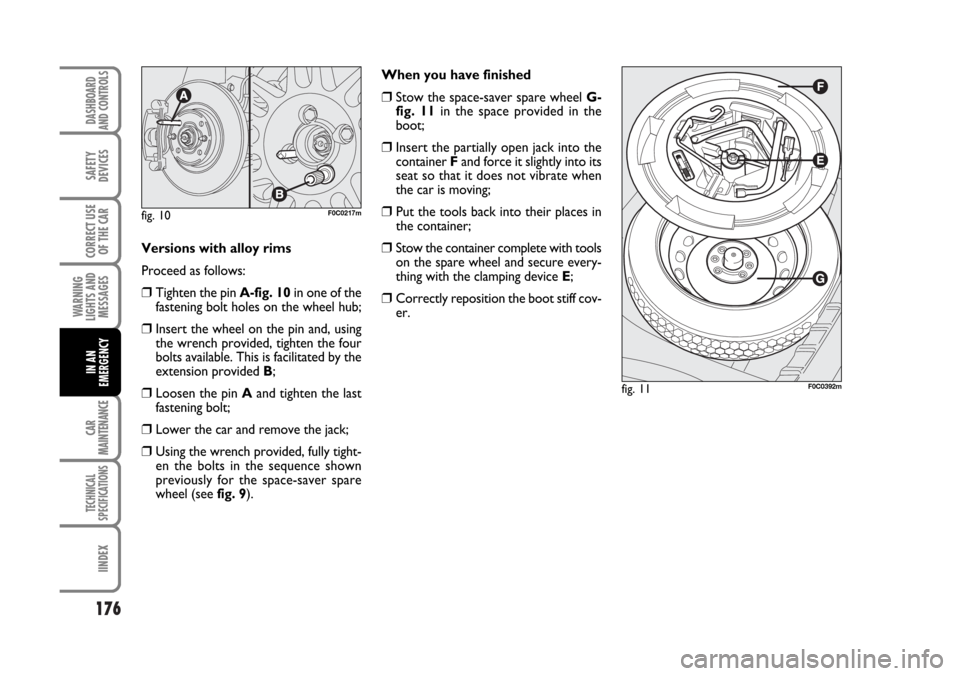
176
WARNING
LIGHTS AND
MESSAGES
CAR
MAINTENANCE
TECHNICAL
SPECIFICATIONS
IINDEX
DASHBOARD
AND CONTROLS
SAFETY
DEVICES
CORRECT USE
OF THE CAR
IN AN
EMERGENCY
Versions with alloy rims
Proceed as follows:
❒Tighten the pin A-fig. 10in one of the
fastening bolt holes on the wheel hub;
❒Insert the wheel on the pin and, using
the wrench provided, tighten the four
bolts available. This is facilitated by the
extension provided B;
❒Loosen the pin Aand tighten the last
fastening bolt;
❒Lower the car and remove the jack;
❒Using the wrench provided, fully tight-
en the bolts in the sequence shown
previously for the space-saver spare
wheel (see fig. 9).When you have finished
❒Stow the space-saver spare wheel G-
fig. 11in the space provided in the
boot;
❒Insert the partially open jack into the
container Fand force it slightly into its
seat so that it does not vibrate when
the car is moving;
❒ Put the tools back into their places in
the container;
❒Stow the container complete with tools
on the spare wheel and secure every-
thing with the clamping device E;
❒Correctly reposition the boot stiff cov-
er.
fig. 10F0C0217m
fig. 11F0C0392m
Page 187 of 274
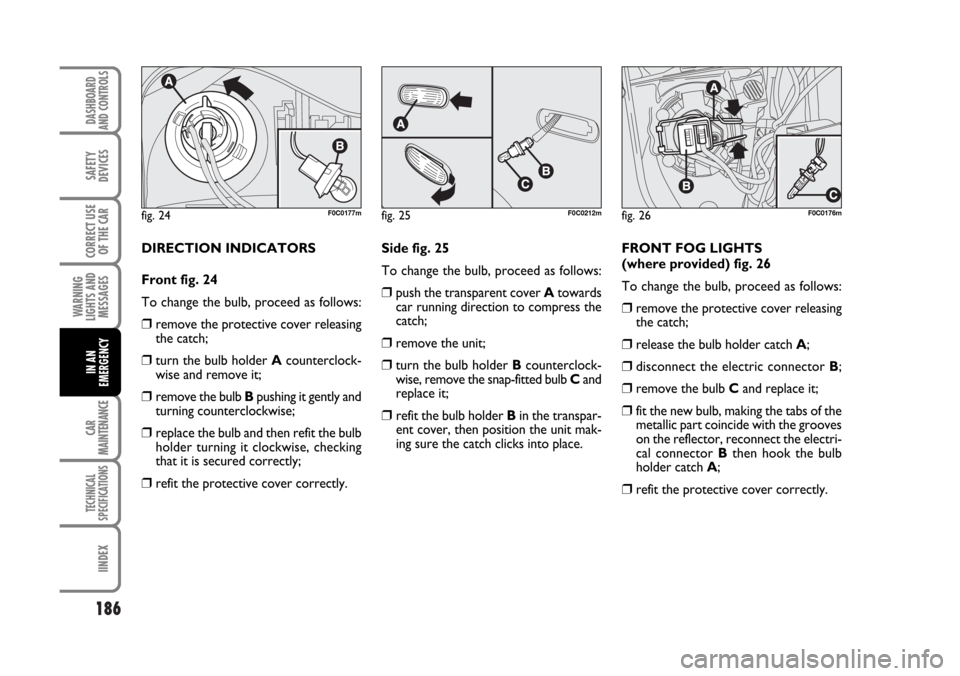
186
WARNING
LIGHTS AND
MESSAGES
CAR
MAINTENANCE
TECHNICAL
SPECIFICATIONS
IINDEX
DASHBOARD
AND CONTROLS
SAFETY
DEVICES
CORRECT USE
OF THE CAR
IN AN
EMERGENCY
DIRECTION INDICATORS
Front fig. 24
To change the bulb, proceed as follows:
❒remove the protective cover releasing
the catch;
❒turn the bulb holder Acounterclock-
wise and remove it;
❒remove the bulb Bpushing it gently and
turning counterclockwise;
❒replace the bulb and then refit the bulb
holder turning it clockwise, checking
that it is secured correctly;
❒refit the protective cover correctly.Side fig. 25
To change the bulb, proceed as follows:
❒push the transparent cover Atowards
car running direction to compress the
catch;
❒remove the unit;
❒turn the bulb holder Bcounterclock-
wise, remove the snap-fitted bulb Cand
replace it;
❒ refit the bulb holder Bin the transpar-
ent cover, then position the unit mak-
ing sure the catch clicks into place.FRONT FOG LIGHTS
(where provided) fig. 26
To change the bulb, proceed as follows:
❒remove the protective cover releasing
the catch;
❒release the bulb holder catch A;
❒disconnect the electric connector B;
❒remove the bulb Cand replace it;
❒fit the new bulb, making the tabs of the
metallic part coincide with the grooves
on the reflector, reconnect the electri-
cal connector Bthen hook the bulb
holder catch A;
❒refit the protective cover correctly.
fig. 24F0C0177mfig. 25F0C0212mfig. 26F0C0176m
Page 207 of 274
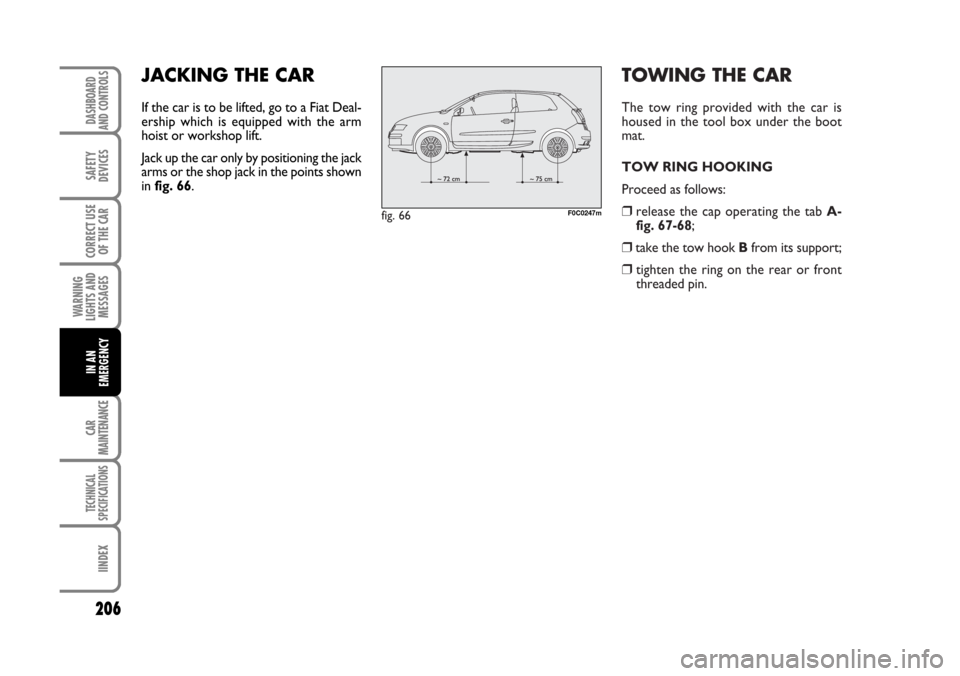
TOWING THE CAR
The tow ring provided with the car is
housed in the tool box under the boot
mat.
TOW RING HOOKING
Proceed as follows:
❒release the cap operating the tab A-
fig. 67-68;
❒take the tow hook Bfrom its support;
❒ tighten the ring on the rear or front
threaded pin.
fig. 66F0C0247m
206
WARNING
LIGHTS AND
MESSAGES
CAR
MAINTENANCE
TECHNICAL
SPECIFICATIONS
IINDEX
DASHBOARD
AND CONTROLS
SAFETY
DEVICES
CORRECT USE
OF THE CAR
IN AN
EMERGENCY
JACKING THE CAR
If the car is to be lifted, go to a Fiat Deal-
ership which is equipped with the arm
hoist or workshop lift.
Jack up the car only by positioning the jack
arms or the shop jack in the points shown
in fig. 66.
Page 208 of 274
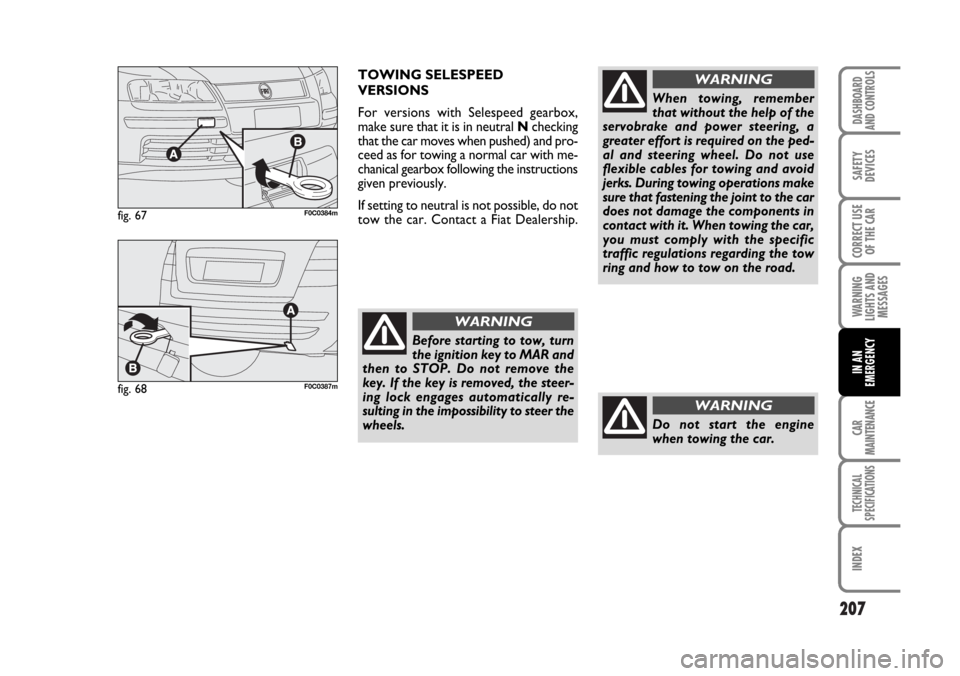
207
WARNING
LIGHTS AND
MESSAGES
CAR
MAINTENANCE
TECHNICAL
SPECIFICATIONS
INDEX
DASHBOARD
AND CONTROLS
SAFETY
DEVICES
CORRECT USE
OF THE CAR
IN AN
EMERGENCY
fig. 67F0C0384m
fig. 68F0C0387m
TOWING SELESPEED
VERSIONS
For versions with Selespeed gearbox,
make sure that it is in neutral Nchecking
that the car moves when pushed) and pro-
ceed as for towing a normal car with me-
chanical gearbox following the instructions
given previously.
If setting to neutral is not possible, do not
tow the car. Contact a Fiat Dealership.
Before starting to tow, turn
the ignition key to MAR and
then to STOP. Do not remove the
key. If the key is removed, the steer-
ing lock engages automatically re-
sulting in the impossibility to steer the
wheels.
WARNING
When towing, remember
that without the help of the
servobrake and power steering, a
greater effort is required on the ped-
al and steering wheel. Do not use
flexible cables for towing and avoid
jerks. During towing operations make
sure that fastening the joint to the car
does not damage the components in
contact with it. When towing the car,
you must comply with the specific
traffic regulations regarding the tow
ring and how to tow on the road.
WARNING
Do not start the engine
when towing the car.
WARNING
Page 211 of 274
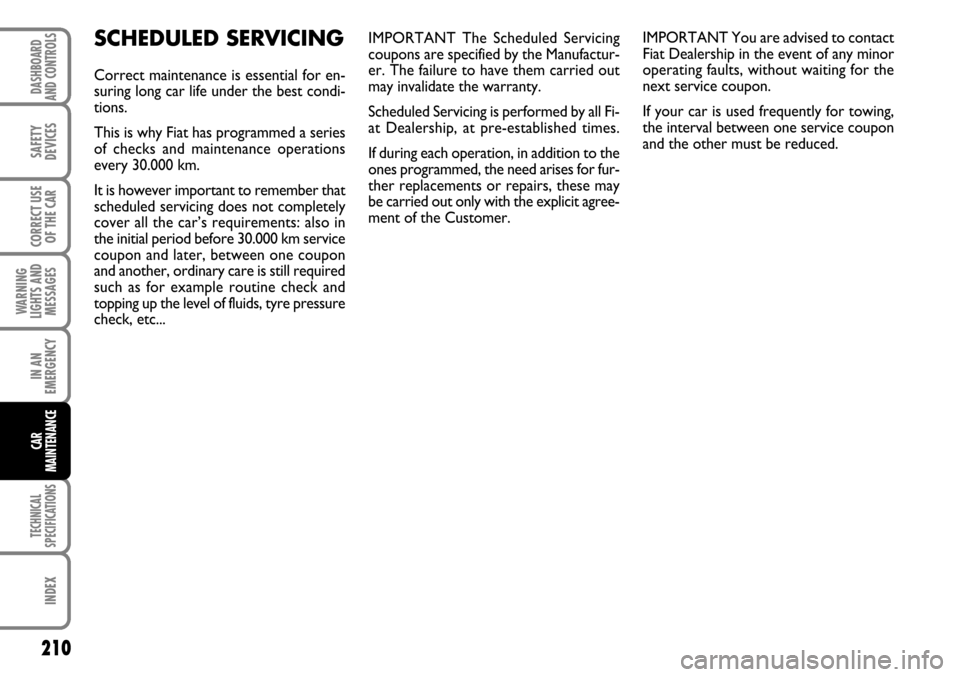
IMPORTANT The Scheduled Servicing
coupons are specified by the Manufactur-
er. The failure to have them carried out
may invalidate the warranty.
Scheduled Servicing is performed by all Fi-
at Dealership, at pre-established times.
If during each operation, in addition to the
ones programmed, the need arises for fur-
ther replacements or repairs, these may
be carried out only with the explicit agree-
ment of the Customer.IMPORTANT You are advised to contact
Fiat Dealership in the event of any minor
operating faults, without waiting for the
next service coupon.
If your car is used frequently for towing,
the interval between one service coupon
and the other must be reduced.SCHEDULED SERVICING
Correct maintenance is essential for en-
suring long car life under the best condi-
tions.
This is why Fiat has programmed a series
of checks and maintenance operations
every 30.000 km.
It is however important to remember that
scheduled servicing does not completely
cover all the car’s requirements: also in
the initial period before 30.000 km service
coupon and later, between one coupon
and another, ordinary care is still required
such as for example routine check and
topping up the level of fluids, tyre pressure
check, etc...
210
WARNING
LIGHTS AND
MESSAGES
TECHNICAL
SPECIFICATIONS
INDEX
DASHBOARD
AND CONTROLS
SAFETY
DEVICES
CORRECT USE
OF THE CAR
IN AN
EMERGENCY
CAR
MAINTENANCE
Page 215 of 274
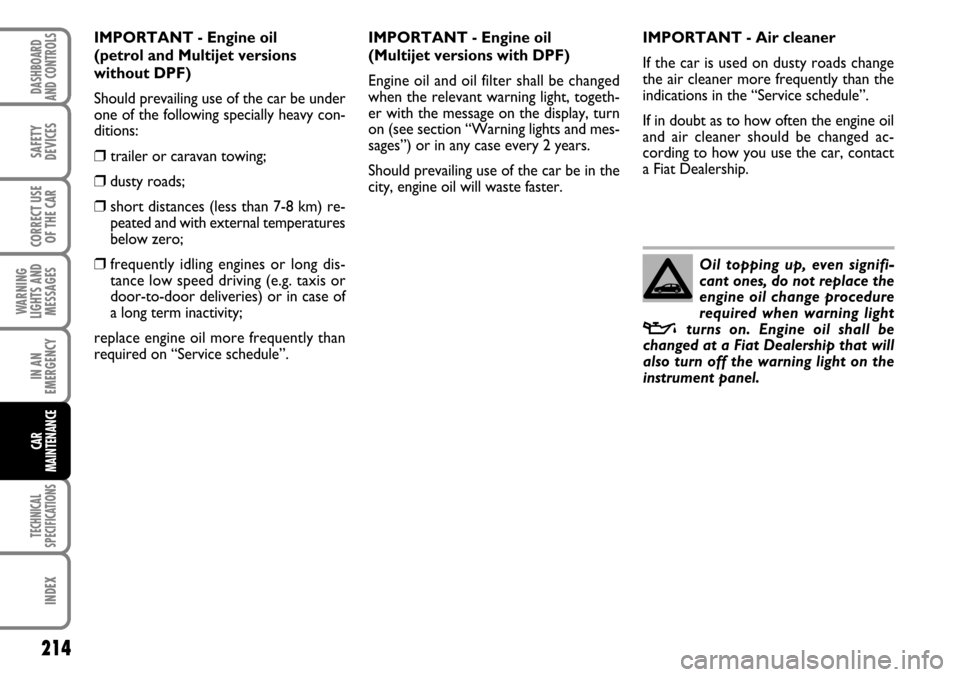
214
WARNING
LIGHTS AND
MESSAGES
TECHNICAL
SPECIFICATIONS
INDEX
DASHBOARD
AND CONTROLS
SAFETY
DEVICES
CORRECT USE
OF THE CAR
IN AN
EMERGENCY
CAR
MAINTENANCE
IMPORTANT - Engine oil
(petrol and Multijet versions
without DPF)
Should prevailing use of the car be under
one of the following specially heavy con-
ditions:
❒ trailer or caravan towing;
❒dusty roads;
❒short distances (less than 7-8 km) re-
peated and with external temperatures
below zero;
❒frequently idling engines or long dis-
tance low speed driving (e.g. taxis or
door-to-door deliveries) or in case of
a long term inactivity;
replace engine oil more frequently than
required on “Service schedule”.IMPORTANT - Engine oil
(Multijet versions with DPF)
Engine oil and oil filter shall be changed
when the relevant warning light, togeth-
er with the message on the display, turn
on (see section “Warning lights and mes-
sages”) or in any case every 2 years.
Should prevailing use of the car be in the
city, engine oil will waste faster.
Oil topping up, even signifi-
cant ones, do not replace the
engine oil change procedure
required when warning light
vturns on. Engine oil shall be
changed at a Fiat Dealership that will
also turn off the warning light on the
instrument panel.
IMPORTANT - Air cleaner
If the car is used on dusty roads change
the air cleaner more frequently than the
indications in the “Service schedule”.
If in doubt as to how often the engine oil
and air cleaner should be changed ac-
cording to how you use the car, contact
a Fiat Dealership.
Page 255 of 274
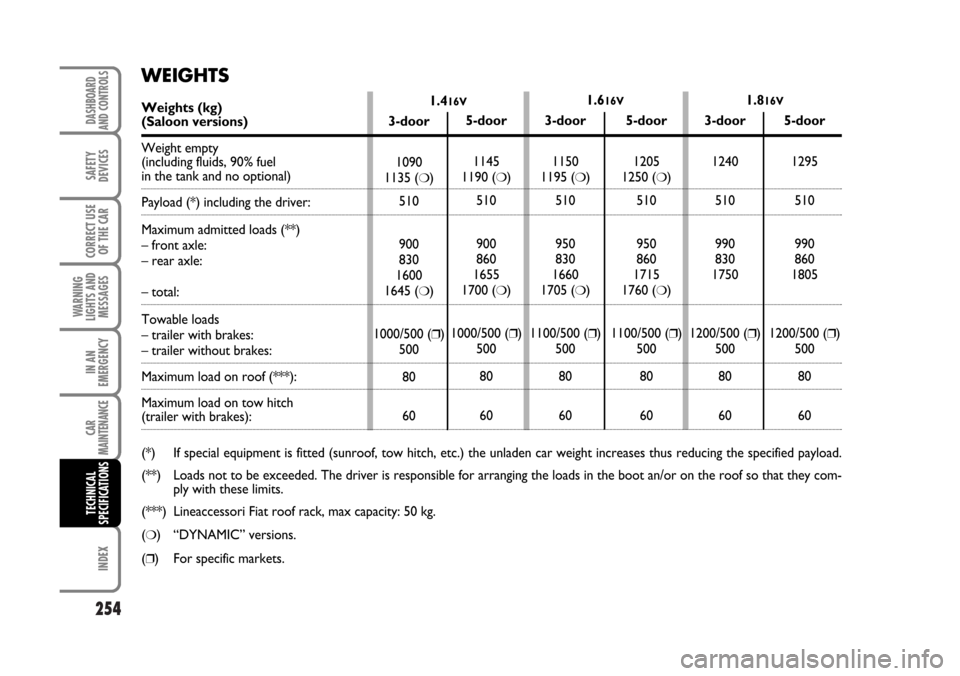
254
WARNING
LIGHTS AND
MESSAGES
INDEX
DASHBOARD
AND CONTROLS
SAFETY
DEVICES
CORRECT USE
OF THE CAR
IN AN
EMERGENCY
CAR
MAINTENANCE
TECHNICAL
SPECIFICATIONS
1.416V1.616V1.816V
WEIGHTS
Weights (kg)(Saloon versions)
Weight empty
(including fluids, 90% fuel
in the tank and no optional)
Payload (*) including the driver:
Maximum admitted loads (**)
– front axle:
– rear axle:
– total:
Towable loads
– trailer with brakes:
– trailer without brakes:
Maximum load on roof (***):
Maximum load on tow hitch
(trailer with brakes):
(*) If special equipment is fitted (sunroof, tow hitch, etc.) the unladen car weight increases thus reducing the specified payload.
(**) Loads not to be exceeded. The driver is responsible for arranging the loads in the boot an/or on the roof so that they com-
ply with these limits.
(***) Lineaccessori Fiat roof rack, max capacity: 50 kg.
(
❍) “DYNAMIC” versions.
(
❒) For specific markets.3-door
1090
1135 (
❍)
510
900
830
1600
1645 (
❍)
1000/500 (
❒)
500
80
605-door
1145
1190 (
❍)
510
900
860
1655
1700 (
❍)
1000/500 (
❒)
500
80
603-door
1150
1195 (
❍)
510
950
830
1660
1705 (
❍)
1100/500 (
❒)
500
80
605-door
1205
1250 (
❍)
510
950
860
1715
1760 (
❍)
1100/500 (
❒)
500
80
603-door
1240
510
990
830
1750
1200/500 (❒)
500
80
605-door
1295
510
990
860
1805
1200/500 (❒)
500
80
60
Page 256 of 274
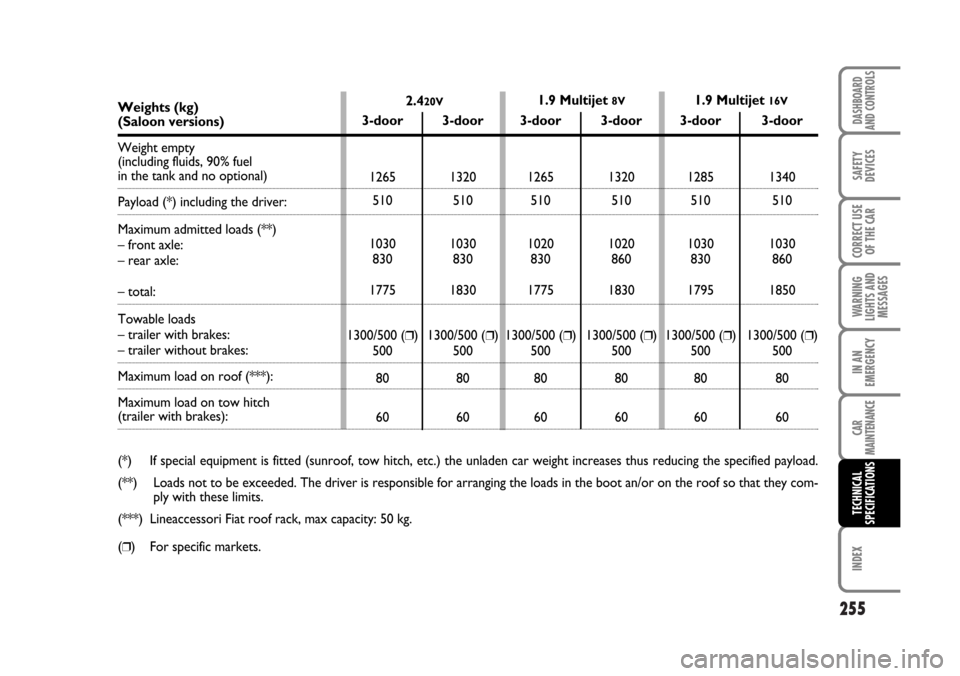
255
WARNING
LIGHTS AND
MESSAGES
INDEX
DASHBOARD
AND CONTROLS
SAFETY
DEVICES
CORRECT USE
OF THE CAR
IN AN
EMERGENCY
CAR
MAINTENANCE
TECHNICAL
SPECIFICATIONS
2.420V1.9 Multijet 8V1.9 Multijet 16VWeights (kg)(Saloon versions)
Weight empty
(including fluids, 90% fuel
in the tank and no optional)
Payload (*) including the driver:
Maximum admitted loads (**)
– front axle:
– rear axle:
– total:
Towable loads
– trailer with brakes:
– trailer without brakes:
Maximum load on roof (***):
Maximum load on tow hitch
(trailer with brakes):
(*) If special equipment is fitted (sunroof, tow hitch, etc.) the unladen car weight increases thus reducing the specified payload.
(**) Loads not to be exceeded. The driver is responsible for arranging the loads in the boot an/or on the roof so that they com-
ply with these limits.
(***) Lineaccessori Fiat roof rack, max capacity: 50 kg.
(
❒) For specific markets.3-door
1265
510
1030
830
1775
1300/500 (
❒)
500
80
603-door
1320
510
1030
830
1830
1300/500 (❒)
500
80
603-door
1265
510
1020
830
1775
1300/500 (❒)
500
80
603-door
1320
510
1020
860
1830
1300/500 (❒)
500
80
603-door
1285
510
1030
830
1795
1300/500 (❒)
500
80
603-door
1340
510
1030
860
1850
1300/500 (❒)
500
80
60